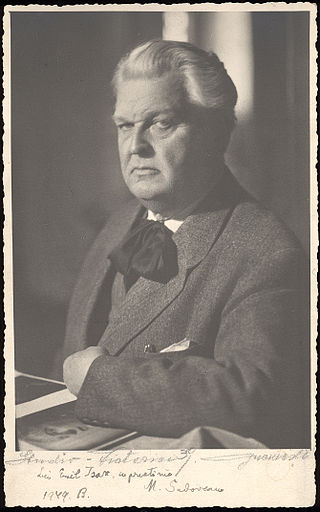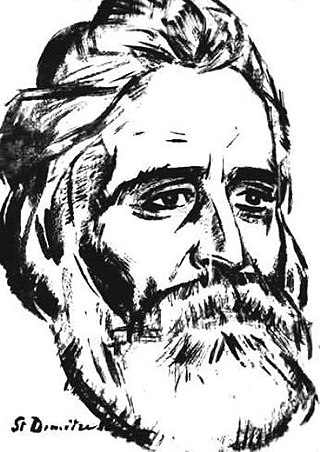
Titu Liviu Maiorescu was a Romanian literary critic and politician, founder of the Junimea Society. As a literary critic, he was instrumental in the development of Romanian culture in the second half of the 19th century.

Mihail Sadoveanu was a Romanian novelist, short story writer, journalist and political figure, who twice served as acting head of state for the communist republic. One of the most prolific Romanian-language writers, he is remembered mostly for his historical and adventure novels, as well as for his nature writing. An author whose career spanned five decades, Sadoveanu was an early associate of the traditionalist magazine Sămănătorul, before becoming known as a Realist writer and an adherent to the Poporanist current represented by Viața Românească journal. His books, critically acclaimed for their vision of age-old solitude and natural abundance, are generally set in the historical region of Moldavia, building on themes from Romania's medieval and early modern history. Among them are Neamul Șoimăreștilor, Frații Jderi and Zodia Cancerului. With Venea o moară pe Siret..., Baltagul and some other works of fiction, Sadoveanu extends his fresco to contemporary history and adapts his style to the psychological novel, Naturalism and Social realism.

Garabet Ibrăileanu was a Romanian-Armenian literary critic and theorist, writer, translator, sociologist, University of Iași professor (1908–1934), and, together with Paul Bujor and Constantin Stere, for long main editor of the Viața Românească literary magazine between 1906 and 1930. He published many of his works under the pen name Cezar Vraja.
Bilete de Papagal was a Romanian left-wing publication edited by Tudor Arghezi, begun as a daily newspaper and soon after issued as a weekly satirical and literary magazine. It was published at three different intervals: 1928–1930, 1937–1938, 1944–1945.

Barbu Ștefănescu Delavrancea; pen name of Barbu Ștefan; April 11, 1858 – April 29, 1918) was a Romanian writer and poet, considered one of the greatest figures in the National awakening of Romania.

The House of Drăculești were one of two major rival lines of Wallachian voivodes of the House of Basarab, the other being the House of Dănești. These lines were in constant contest for the throne from the late fourteenth to the early sixteenth centuries. Descendants of the line of Drăculești would eventually come to dominate the principality, until its common rule with Transylvania and Moldavia by Mihai Viteazul in 1600.

Mărgărita Miller-Verghy was a Romanian socialite and author, also known as a schoolteacher, journalist, critic and translator. A cultural animator, she hosted a literary club of Germanophile tendencies during the early part of World War I, and was later involved with Adela Xenopol in setting up feminist cultural venues. Her main contributions to Romanian literature include translations from English literature, a history of feminine writing in the national context, a novella series and an influential work of detective fiction. Many of her other works have been described as mediocre and didactic.

The Alexandru Ioan Cuza University is a public university located in Iași, Romania. Founded by an 1860 decree of Prince Alexandru Ioan Cuza, under whom the former Academia Mihăileană was converted to a university, the University of Iași, as it was named at first, is one of the oldest universities of Romania, and one of its advanced research and education institutions. It is one of the five members of the Universitaria Consortium.

Luca Ion Caragiale, also known as Luki, Luchi or Luky Caragiale, was a Romanian poet, novelist and translator, whose contributions were a synthesis of Symbolism, Parnassianism and modernist literature. His career, cut short by pneumonia, mostly produced lyric poetry with cosmopolitan characteristics, distinct preferences for neologisms and archaisms, and willing treatment of kitsch as a poetic subject. These subjects were explored in various poetic forms, ranging from the conventionalism of formes fixes, some of which were by then obsolete, to the rebellious adoption of free verse. His poetry earned posthumous critical attention and was ultimately collected in a 1972 edition, but sparked debates among literary historians about the author's contextual importance.

Păstorel Teodoreanu, or just Păstorel, was a Romanian humorist, poet and gastronome, the brother of novelist Ionel Teodoreanu and brother in law of writer Ștefana Velisar Teodoreanu. He worked in many genres, but is best remembered for his parody texts and his epigrams, and less so for his Symbolist verse. His roots planted in the regional culture of Western Moldavia, which became his main source of literary inspiration, Păstorel was at once an opinionated columnist, famous wine-drinking bohemian, and decorated war hero. He worked with the influential literary magazines of the 1920s, moving between Gândirea and Viața Românească, and cultivated complex relationships with literary opinion-makers such as George Călinescu.
Bogdan Suceavă is a Romanian-American mathematician and writer, working since 2002 as professor of mathematics at California State University Fullerton. He is also a honorary research professor with the STAR-UBB Institute, Babeș-Bolyai University, Cluj-Napoca, Romania.
Mihai Codreanu was a Romanian poet, particularly noted for his sonnets. A native and lifelong resident of Iași, he published his first volume of verse in 1901, followed by another two years later that solidified his reputation. Aside from another book of sonnets in 1914 and two during the 1920s, he authored three highly successful translations of French plays. He also edited a series of newspapers and wrote widely for an array of literary reviews. Attracted to the stage from early on, he led and reformed the main theatre in his city for several years after World War I, and during the 1930s presided over the arts school in Iași. Beginning in 1905, he developed an eye disease that soon left him unable to read or write, tasks that he accomplished through intermediaries.

Ionel Gherea, also known as Ioan Dobrogeanu-Gherea or Ion D. Gherea, was a Romanian philosopher, essayist, and concert pianist. The son of Constantin Dobrogeanu-Gherea, a Marxist theoretician and critic, and the brother of communist militant Alexandru "Sașa" Gherea, he was only mildly interested in politics of any kind, embracing an apolitical form of left-libertarianism. Largely self-taught, he became interested in the aestheticism of his brother-in-law, Paul Zarifopol, who became one of his main references. As a youth, Zarifopol took him to meet playwright Ion Luca Caragiale and his family, who were also influential on Gherea's writing, and the focus of his old-age memoirs. Gherea's debut as a writer was a 1920 novel written jointly with Luca Caragiale, which was also his only contribution to the genre. Following Constantin's death and Sașa's imprisonment, he had to handle family affairs, but his mismanagement of their money led him into remorseful despair; in 1924, he briefly disappeared, and was presumed to have committed suicide.

Vintilă Russu-Șirianu was an Austro-Hungarian-born Romanian journalist, memoirist, and translator.

Profira Sadoveanu, also credited as Profirița and known after her marriage as Sadoveanu Popa, was a Romanian prose writer and poet, noted as the daughter, literary secretary, and editor of the celebrated novelist Mihail Sadoveanu. She was born during her father's stay in Fălticeni, on the traditional border between Western Moldavia and Bukovina, and is sometimes regarding as belonging to a Bukovinan literary tradition. She had fond memories of the place, where she had a carefree childhood on her paternal estate. During the campaigns of World War I, the family relocated to the urban center of Iași, purchasing a villa on Copou Hill. Profira's adolescence saw her socializing with some major figures in Romanian literature, who were friends of her father. Her own debut as a poet, in the 1920s, was overseen by George Topîrceanu.
Mihail Șerban was a Romanian prose writer.

The Zlataust Church is a Romanian Orthodox church located at 5 Zlataust Road in Iași, Romania. It is dedicated to Saints John Chrysostom and Theodore of Amasea.

Ștefana Velisar Teodoreanu was a Romanian novelist, poet and translator, wife of the writer Ionel Teodoreanu. Encouraged to write by her husband, she was a late representative of Poporanist traditionalism, which she infused with moral themes from Romanian Orthodoxy, and also with echos of modernist literature. Her works of youth, coinciding with World War II, comprise mainly novels centered on the internal conflicts and moral triumphs of provincial women such as herself. Forming a counterpart to her husband's own books, they won praise in their day, but were later criticized for being idyllic and didactic.

La Medeleni is a trio of novels written by Ionel Teodoreanu. The books were set in the village of Medeleni, in Iași County, Romania. The trilogy includes: The Fickle Border published in 1925, Roads published in 1926, and Between the Winds published in 1927. Teodoreanu’s inspiration for the novels came from a mansion on the bank of the river Prut where friends from the literary world would gather. On May 21 2016, the mansion became a museum in memoriam of Ionel Teodoreanu.

The National College is one of the oldest and most prestigious high schools in Romania, located in Iași, at 4 Arcu Street.
















